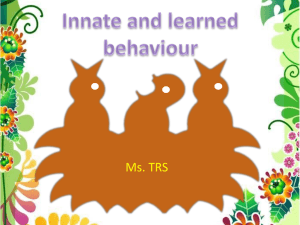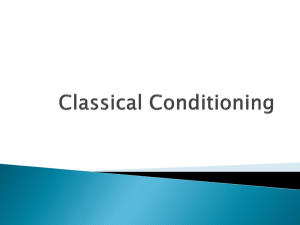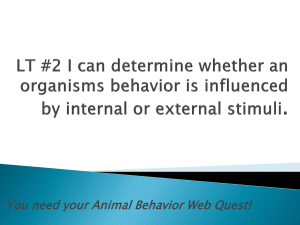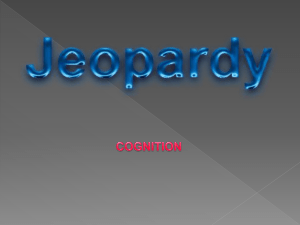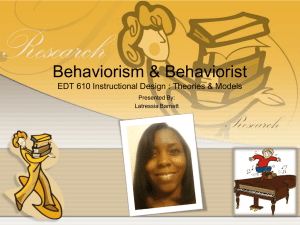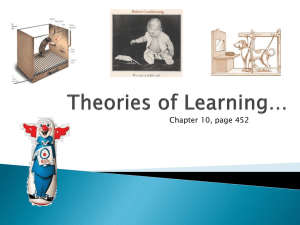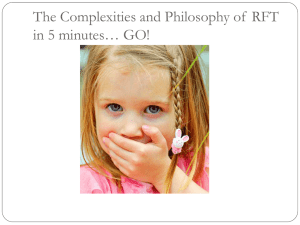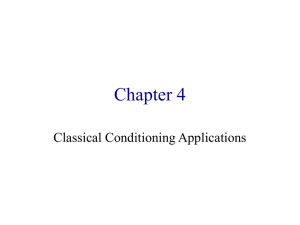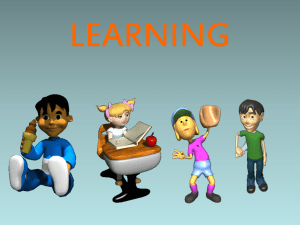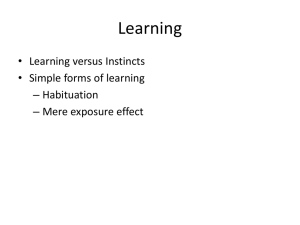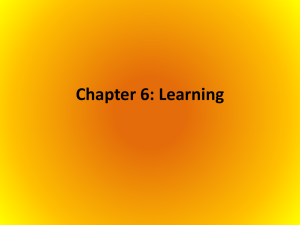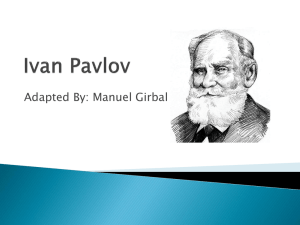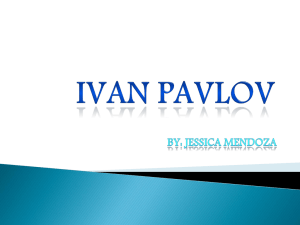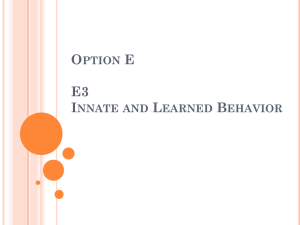Innate/Learned Behavior Powerpoint
advertisement
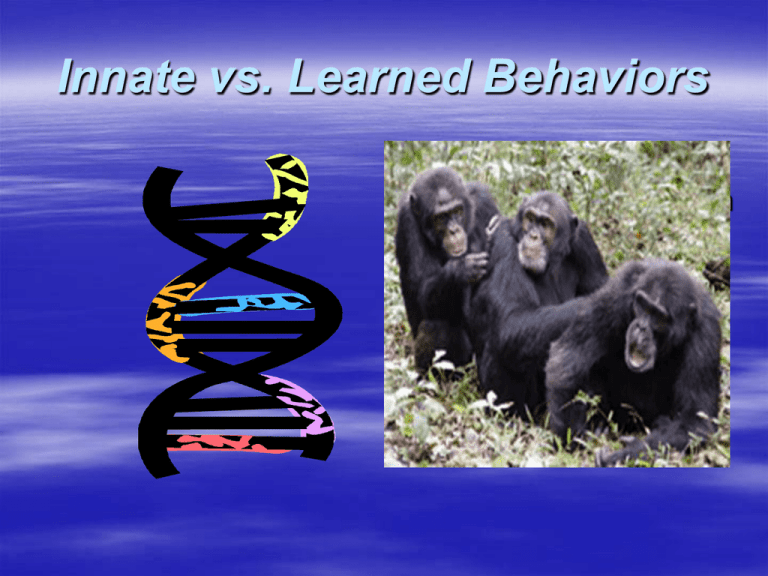
Innate vs. Learned Behaviors http://www.sparknotes. com/biology/animalbeh avior/learning/problem s_1.html What is Behavior? An activity or action that helps an organism survive in its environment. Behavior can be thought of as the way an animal acts. Blinking, eating, running, walking, flying, sleeping are all examples of animal behavior. Animals behave in certain ways for four basic reasons to find food to interact in social groups to avoid predators to reproduce Stimulus A behavior comes in response to a stimulus. A stimulus is any change in the environment that affects the activity of an organism or what causes an animal to act in a certain way. Examples of Stimuli Stimuli may include: • the sight of food • the sound of a potential predator • the smell of a mate • daily events such as nightfall • seasonal events such as decreasing temperatures. Releasing Stimulus Triggers the Organisms Nervous System to do a behavior Innate Behaviors Innate behaviors are not learned, you are born with them. Fully functional the first time they are performed No experience needed to acquire behavior Inherited: Genes determine behavior Examples of Innate Behaviors 1. Fish 2. Chickens 3. Lovebirds 4. Mammals Ability to swim Pecking Nest Building Suckling to get milk Egg Rejection Egg Rejection by Cukoos is an innate behavior. Brood Parasites: birds which never build their own nests and instead lays their eggs in the nest of another species leave those parents to care for its young. http://www.youtube.com/wat ch?v=JMkpdsud-F4 Migration Migration is an innate behavior. Migration is the seasonal movement of animals from one place to another. This behavior allows the animals to take advantage of resources like food or water when they run low in another location. Hibernation Hibernation is an innate behavior. Hibernation is a resting state that helps animals survive the winter. During hibernation a warm-blooded animal like a ground squirrel slows down its heart rate and breathing rate. Fixed Action Pattern An innate pattern of behavior Immerged at birth In tacked first time its done Performance and maturation can shape it / improve it further Always runs to completion Examples of FAP’s 1. A squirrel opening a nut 2. Rhesus Monkeys and Subordinate Gestures Example of Human FAP’s 1. Smile, Frown, etc. 2. Yawning 3. Eye blinking Learned Behaviors Behaviors animals are NOT born with Acquired / Modified by experience Behaviors are learned from observations and experience Often learned from parents Types of Learned Behavior Non-Associative Learning Habituation Sensitization Associative Learning Classical Conditioning Operant Conditioning (Trial and Error) Latent Learning Imprinting Insight (Reasoning) Non-Associative Leaning Organisms change their response to a stimuli without association with a positive or negative reinforcement. 2 Types: 1. Habituation 2. Sensitization Habituation A decrease in response to a stimulus after repeat exposure Less sensitive to stimuli Eliminates responses that have no value on an animals survival or welfare. Helps prevent waste of energy Example of Habituation Prairie dogs and humans A bird and a stuffed cat Snail and tapping Sensitization The increase that occurs in an organism’s responsiveness to stimuli following an especially intense or irritating stimulus. More sensitive to stimuli Depending on the intensity and duration of the original stimulus, the period of increased responsiveness can last from several seconds to several days. Example of Sensitization Sea snail that receives a strong electric shock Will afterward withdraw its gill more strongly than usual in response to a simple touch. Associative Learning Organisms change their response to a stimuli with association of a positive or negative reinforcement. 2 Types: 1. Classical Conditioning 2. Operant Conditioning Classical Conditioning Experiment by Ivan Pavlov Pavlov began to observe salivation in dogs 1. He would enter the room and place meat powder or a food morsel on tongue and wait for salivation to occur 2. He began to see that the dogs were salivating as soon as he entered the room, which was before any food was even in sight. 3. The dogs became conditioned by Pavlov to have expectations. When he entered the room, the dogs expected food; therefore, they began salivating in expectation Neutral Stimulus A neutral stimulus is something that normally would not produce any salivation Pavlov chose to ring a bell since ringing a bell would not normally produce salivation in the dogs. Pavlov began ringing a bell before placing the meat powder or item on the dog's tongue Each and every time that the bell was rung, meat powder or food was given to the dog. Pavlov repeated these experiments many, many times. Eventually, the bell alone was enough to make the dogs salivate. This proved that a neutral stimulus that elicited no response whatsoever from the dogs before was now causing a response- salivation. The dog had learned to associate the sound of the bell with food. Classical Conditioning in Summary Unconditioned Stimulus Stimulus that leads to a response with NO training Ex. Food Conditioned Stimulus A former neutral stimulus that comes to elicit a given response after pairing with an unconditioned stimulus. Ex. Bell Unconditioned Response Automatic Response to an unconditioned stimulus. Ex. Salivate Conditioned Response A learned response to a conditioned stimulus. Ex. Salivate What did this prove? Pavlov's experiment proved that all animals could be trained or conditioned to expect a consequence on the results of previous experience. Operant Conditioning an unassociated behavior becomes associated with a reward B.F. Skinner designed an apparatus called a "Skinner box" to test the interaction between UCS and CS Skinner Box A rat was placed inside the Skinner box If the rat pressed down a lever inside the box then the box would release a food pellet Soon, the rat pressed the lever far more often than he would just by chance. But with each instance of lever pressing, the operant is reinforced by reward with food. The rat learns that pressing the lever is associated with food, and so he will increasingly press it. Training Rats in a Skinner Box Classical vs. Operant In classical conditioning, the animal receives no benefit from associating the CS with the UCS. Latent Learning When an organism learns something in its life, but the knowledge is not immediately expressed. Knowledge remains dormant until certain circumstances allow or require it to be expressed Learning WITHOUT REWARDS! No association with a positive or negative stimulus. Example of Latent Learning Place a rat in a maze with no food The rat will simply run around the maze, familiarizing itself with the surroundings. If you then return the rat to the same maze the next day and add food, the rat will find the food much more quickly then will a rat placed in the maze with food for the first time. Imprinting Process by which a social attachment to a particular object is formed during a critical time period. Critical Time Period: Prior to birth to somewhere around 30 hr old Early in life when recognition is critical Irreversible Work done by Konrad Lorenz Insight Learning Type of learning or problem solving that happens all-of-a-sudden. Prior experience is crucial to learning Investigations are difficult because the learning happens quickly Identified by Wolfgang Kohler Example of Insight Learning Köhler placed a banana outside the cage of a hungry chimpanzee, Sultan, and gave the animal two sticks, each too short for pulling in the food but joinable to make a single stick of sufficient length. Sultan tried unsuccessfully to use each stick Later, after apparently having given up, Sultan accidentally joined the sticks, observed the result, and immediately ran with the longer tool to retrieve the banana.
